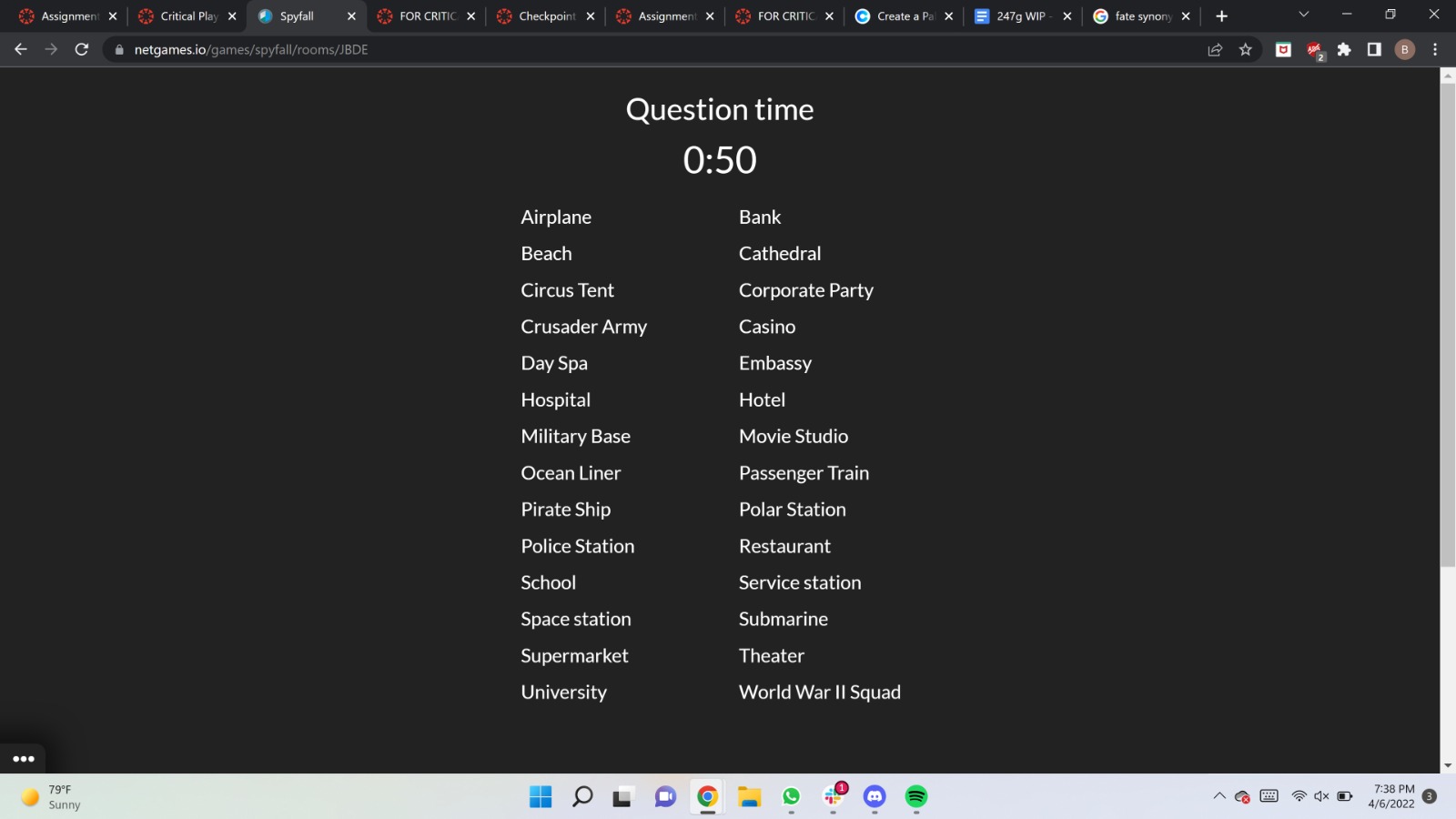Critical Play: SPYFALL
General Information
- Spyfall by Alexander Ushan
- Played as an online game
Target audience
- The target audience of Spyfall is ages 13+ (according to tabletop version)
Notable elements of the game
- Number of players: 4-12 people (We played with 4)
- For four minutes, players can ask each other questions, then the person who is asked the question has to answer. Players then vote for the person who they think doesn’t know the location (the spy) at the end of the time limit. If they unanimously vote correctly, the spy can try to guess the location correctly, and if they do, they win. Otherwise, they lose and everyone else wins. If they elect the wrong player as the spy, the spy wins.
- Types of players:
- The spy — try to blend in and guess the location using others’ questions and answers
- Other players — figure out who the spy is
- Formal Elements:
- Players: Unilateral Competition
- Objectives: Different per role (see above)
- Outcomes: Zero-sum (Spy wins or Players win)
- Boundaries: Undefined (Within audible range; varies from tabletop to online)
Comparable To Other Games in the Genre
- Of the games I know, I found the game to be most similar to Mafia because of the social element of its deception. While for all the games, all players are on even footing and are trying to identify one “imposter”, in both Spyfall and Mafia, the “imposter” is trying to verbally convince other players that they are innocent, and pin the blame on others.
- Building on the above point, I enjoyed the social aspect of the game because it felt less structured, with infinite possibilities of questions to ask and responses to give. There were many points in the game where if you did know the answer, you still would not want to be too specific in order to not give away the location. Thus, everybody was able to participate in the careful answer-giving (as opposed to games like Mafia, where being a villager means strictly less interaction)
- Strengths: Fun concept — felt exciting to play in both roles; creative type of deception, where while roles were uneven, all players were all still trying to achieve the similar goal of providing vague answers and asking vague questions
- Weaknesses: Poor execution — very weak selection of locations, and the game felt bound at times because of certain design decisions (detailed below); also could be frustrating to play at times because of these decisions
Was the game fun? Why or why not?
- The game on average felt fun to me, with the caveat that at times certain rounds would feel frustrating or disappointing. I loved the concept of the deceiver knowing less information than the other players, as I feel like most other games in the genre give more power to the deceiver (ex: Mafia).
- Poor execution: While I liked the idea, some of the specific implementation details were poor:
- Location Selection: Locations felt too sporadic and limited; some locations were events, others were time periods, which made it very difficult for the imposter to go first, but also gave away too much information if they went last)
- Time Limit: The time limit provided was very short in our experience; as we played the game, we started asking questions faster, so the appropriate time limit would depend on the number of players and their respective familiarity.
- Unanimous Vote: If the group cannot come to a consensus, there is a deadlock, which can be very hard to break out of due to limited time to discuss
- Game Players and Order: The game speed / fairness depends greatly on the number of players and the order in which players ask questions (by chance). There is a much higher chance of failure for the spy if they are asked a question first.
- UI: While a simple UI is appropriate for this game, the locations were displayed in alphabetic order, which made it much more difficult for the spy; since we only played with 4 players, the questions fell on the spy much quicker, requiring them to think much faster on average

Moments of particular success or epic fails
- Successes:
- Accidentally giving away too many hints, but still having the spy botch their location guess
- Creating a deadlock in the voting while being the spy (Deadlock was unfun, but with the small number of people, the spy almost always lost, so it felt good to get close)
- Failures:
- On our second to last round, the location was “crusader army,” which felt too strangely specific for people to give accurate answers, which made it easier for the spy (me) to blend it, but also made the game feel slow and less interesting. Eventually, I ended up guessing “military base,” which felt too similar (WWII squad was also an option, which feels also too similar).
- On our last round, the location was “hotel,” but because of a misinterpretation of words, the spy (me, again) ended up being identified, and because it was hard to understand each other under the time pressure, some of the clues got messed up, which made it very difficult to guess the location.
Things you would change to make the game better
- Overall, I very much liked the concept of the game. However, in terms of execution, I would change the following:
- Location selection: Replace some irrelevant / strange locations (like Crusader Army, WWII Squad) with more common but unique locations (Central Park, Middle of Busy Street, etc.)
- Marginal improvements to UI (Allowing spy to move locations around to sort them, etc.)
- Greater restraint on number of players (Possibly having multiple spies at greater numbers, just to make the gameplay much less varied)
- Time Limit: Set a greater time limit (Or allow players to select their own)


